The Art Teacher
Art Lesson Ideas, Plans, Free Resources, Project Plans, and Schemes of Work. An 'outstanding' art teacher in Greater Manchester. Teaching KS3 and KS4 art and design.

GCSE Artist Research Guide
Creating research about artists is a creative and exciting part of a GCSE course. It will allow you to discover new artworks and learn about how artists think and work.
This GCSE artist research guide will help you find an appropriate artist, analyse their work and present your research to a GCSE standard. The purpose of research in GCSE Art is to help you understand the artist’s style , techniques / processes and themes . You will use this knowledge to inform your own artwork.
Researching artists / art exhibitions / photographers / designers is an important aspect of your GCSE Art course and can help you improve your own work and generate new ideas.

Successful GCSE artist research pages are produced by collecting information and images about an artist you are studying or want to study. Your research should include:
- A brief biography of the artist
- Pictures of their artwork
- Analysis of their artwork(s)
- The inspiration behind their pieces
- Your own response

A guide to creating high quality artist research:
- It is important to choose a relevant artist. If your project is about portraits , you shouldn’t really be looking at artists who specialise in landscapes !
- You should also choose an artist that you like . It’s no good choosing an artist if you think their work is boring.
- Use an artist who has similar skills to you. Do you prefer drawing? Avoid painters!
- This will show that you understand the context of their work.
- This will make your research look more professional.
- Artists often use social media to show their processes. Online museums and galleries also share information about the artist’s work or techniques.

How to present your artist research:
Once you have found an artist that you’re interested in and you have started to research them, you need to present what you have found. Use these tips to help show off your research:
- Plan your layout
- Include colours related to the artist
- Have a clear title
- Write neatly, checking spellings and grammar
- Type up annotations if it will help you
- Create a response using the same materials as the artist (eg. acrylic paint)
- Create your research on a computer if it will help you
DON’T:
- Spend hours on a fancy title
- Spend hours on a fancy background
- Feel like you need to write lots and lots
- Copy a full piece of the artist’s work – a colour study, or a section of their work is enough to learn from them
Let’s look at a good example of GCSE artist research :

- The layout is simple and clear; the background lines link to the artworks.
- The student has stuck to black and white, just like the artist.
- The title is clear and reflects the ‘glitch’ style of the art
- The writing is neat, along straight lines
- The drawing is high quality and uses appropriate materials (pencil and white pen). The student has clearly studied the artist’s work carefully.
How to analyse artwork:
You should choose a piece of artwork by the artist to analyse . Writing an image analysis about art can seem strange because there are no absolutely ‘correct’ answers. However, if you’re not sure how to analyse artwork, this guide to analysing art can help.
You don’t need to answer every question, but aim for at least 2 or 3 from each section:

Artist: Janet Fish Title: “Untitled (Two Packages of Pears)” Date: (1969) Medium: oil on canvas Size: 52 1/4″ x 42″
Let’s analyse an artwork using some questions from the “Content, Form, Process, Mood” Guide:
What can you see in the picture? Think about objects, colours, shapes and textures. The painting shows two packets of green pears, there are six in total. They are still in the wrapper and there are a lot of reflections painted to show the plastic covering them. What is the composition (layout) of the work? The pears fill the whole canvas and we can’t see much of the background. There is some symmetry with three pears on each side. Is there a colour scheme? Why or why not? There is a limited, harmonious colour palette of calm greens, blues and yellows. The colours are quite realistic and natural to reflect the subject matter. Is it realistic, or surreal, or both? Why? Overall the piece has realistic and surreal elements due to the sharp shapes of the light reflections that add contrast to the soft natural shapes. The shape of the reflections stand out against the soft round edges of the pears. How was the artwork made? The artist has used oil paints which enhances the glossy, plastic effect. Do you think the artist made any other versions or sketches? I think they would have sketched different layouts and mixed tester colours to match the fruit carefully.
Creating your own artist response:
Your response to an artist or artwork should use the same (or similar) materials to the artist. You might choose to focus on their use of colour or composition for example.
You should always include your opinion about an artist’s work in your research, explaining why you like/dislike their work.
You should also explain how it will inspire you or influence your own work.

In this artist research example the student has studied the artwork of Tjalf Sparnaay. Their response is a good quality drawing of a fried egg, copied from one of the artist’s paintings. The artist is a hyperrealist painter, but the student has responded with coloured pencils, showing skill in the accuracy of their drawing and managing to show some realism in their work through natural colours and a range of tones.

In this example, the student has researched the ceramic artist Mechelle Bounpraseuth . Their response doesn’t use clay like the artist, but the student has used the same idea as Bounpraseuth and chosen to draw a food object that reminds them of their family / friends. The drawing is highly skilled, showing a range of tones and highlights with exceptional attention to detail.

GCSE Artist Research examples:

Get art resources sent straight to your email:
Type your email…
Artist research page checklist:
Now that you’re got an idea of what good artist research looks like, download the checklist below to use and help make sure you have included everything you need.
This artist research page checklist is simple to use and will make sure you / your students have included everything they need to make a successful, GCSE standard artist research page!
Sharing is caring
3 thoughts on “ gcse artist research guide ”.
Amazing work thanks
Like Liked by 1 person
- Pingback: Evaluation – My Art & Design Foundation Diploma
The artist work is really very good and amazing.
Thank you so much.
Leave a comment Cancel reply
Published by art_teacher_mcr
Making and teaching art. Based in Manchester. View all posts by art_teacher_mcr

- Already have a WordPress.com account? Log in now.
- Subscribe Subscribed
- Copy shortlink
- Report this content
- View post in Reader
- Manage subscriptions
- Collapse this bar
- Cover/sub lesson
- Women artists
- Contemporary artists
- Scheme of Work
- Literacy in art
Handouts to get great artist research & analysis
- by AMIMAMIM
- February 8, 2017 April 14, 2020

One simple step to improve artist research in your students sketchbooks: give them the material – text information, images and questions – they need to come up with meaningful insights and high quality responses. Easier said than done, possibly… I have long been perplexed at the lack of writing and publishing on the artists that are most inspirational to young people. There are plenty of writing frames out there, and suggested approaches to analysis, but succinct and accessible materials? Not so much…
So, I have started a bank of my own. They are time consuming and take a fair bit of thought, particularly working out practical responses that are more than just copying or pastiche for each artist, but they have proved so useful and versatile in the classroom. I have posted an example below (click on the text below to download the ppt file) on the artist Angie Lewin who makes stunning prints inspired by plants and nature – she is a real favourite with students…
Click to download here : angie-lewin-artist-research-handout
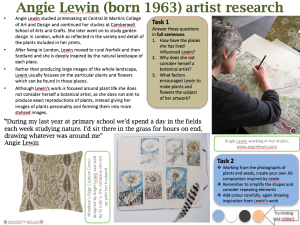
Theses are some of the artists I have produced sheets on:
- Peter Blake
- Georgia O’Keeffe
- Frida Kahlo
- William Morris
- Giorgio Morandi
- Hilma Af Klint
- Ernst Haeckel

All of these are available as digital downloads in the felt-tip-pen resources shop , or you can find them in my Teachers Pay Teachers store . There’s thumbnail of each at the bottom of this post, to give you a better idea.
I hope they are useful to you – perhaps also for cover lessons, extension tasks, or independent learning? Let me know what you think – I’d love suggestions for other artists. You can also find a general artist research template here .

Save Save Save Save

Share this:
- Click to share on Facebook (Opens in new window)
- Click to share on Pinterest (Opens in new window)
- Click to share on Twitter (Opens in new window)
- Click to email a link to a friend (Opens in new window)
4 thoughts on “Handouts to get great artist research & analysis”
Pingback: How to get high quality artist response outcomes ⋆ felt-tip-pen
Pingback: 'How to do Artist Research': new worksheet ⋆ felt-tip-pen
Pingback: LGBT history month is ⋆ felt-tip-pen % % %
Pingback: Art cover lessons that work ⋆ felt-tip-pen
Comments are closed.

How to Research an Artist or a Work of Art
Find articles, contemporary artists, gallery websites, keyword search tips.
- How to research a work of art

This guide walks you through the steps of researching an artist and of researching a work of art.
The following resources can provide lots of great biographical information on artists. Check for bibliographies on articles.
In many databases you can narrow your search to certain "content types." Look for:
- Biographies
- Exhibition Catalogs
- Periodicals
Off-campus access is limited to SIA faculty, students, and staff, unless otherwise noted.
The more traditional resources in this guide may not cover contemporary artists. A few suggestions are listed below for locating information on contemporary artists. Cleveland Institute of Art's Contemporary Artist Index is a database that lists over 31,000 artists appearing in more than 1,800 exhibition catalogs and art publications.
Gallery websites will often contain some basic information on the artists they represent. A simple Google search may lead you to an artist's gallery.
If not, try searching for the artist in the ArtNet Artists A-Z list . Artist information will often include a link to a list of dealers representing the artist as in the example below from ArtNet for the artist Rashaad Newsome

One of the dealers listed is Marlborough Gallery. If you go to the Marlborough Gallery website, you will find a lot of biographical information provided on the artist's page.

Selected examples of subject search terms to use in databases and library catalogs. Terms can all be modified by place names, e.g., Expatriate artists -- United States . You may also search by the name of an artist, either as an author or as subject.
| African American artists | Cartoonists | Landscape painters |
| African American women artists | Child artists | Lithographers |
| Art teachers | Commercial artists | Mexican American artists |
| Artist colonies | Costume designers | Painters |
| Artists | Designers | Performance artists |
| Artists -- Africa | Engravers | Portrait painters |
| Artists -- Asia | Etchers | Potters |
| Artists -- Biography | Expatriate artists | Pre-Raphaelites |
| Artists -- Europe | Fashion designers | Printmakers |
| Artists -- Great Britain | Fashion illustrators | Sculptors |
| Artists -- New York | Folk artists | Textile designers |
| Artists -- Latin America | Furniture designers | Women artists |
| Artists -- Psychology | Glass artists | Women fashion designers |
| Artists -- United States | Illustrators | Women painters |
| Artists and community | Indian artists | Women potters |
| Artists and patrons | Industrial designers | Women sculptors |
| Artists with disabilities | Interior decorators | Wood-engravers |
| Botanical artists | Jewish artists | Woodworkers |
- Next: How to research a work of art >>
- Last Updated: Feb 22, 2024 3:57 PM
- URL: https://sia.libguides.com/c.php?g=521226

- Free Resources
- Register for Free
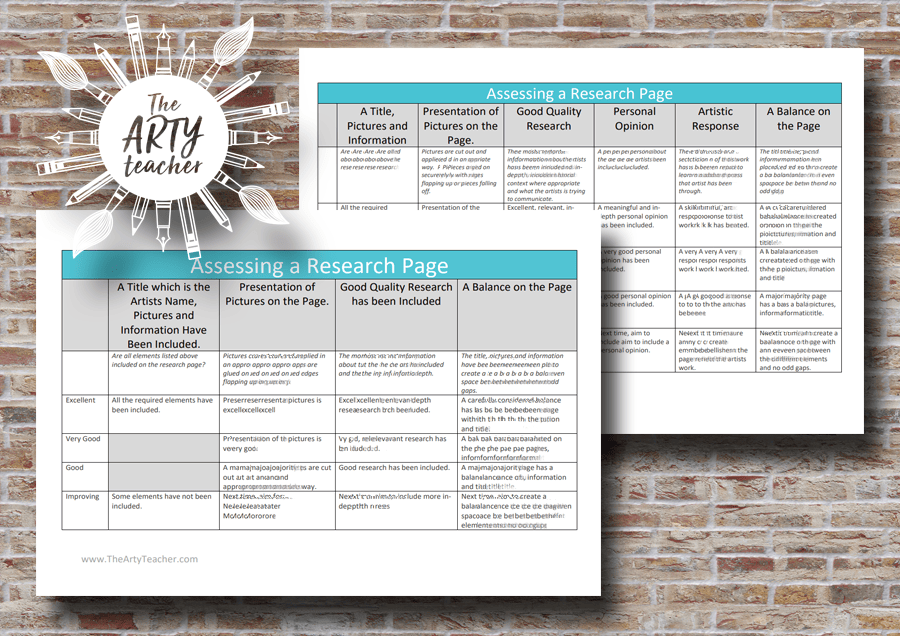
Assessing An Art Research Page
I want to pay in australian dollars ($) canadian dollars ($) euros (€) pound sterling (£) new zealand dollar ($) us dollars ($) south african rand change currency, description.
We all look for different things when assessing an art research page. That is why this download includes two different, editable versions of an assessment rubric. A basic version and a comprehensive version.
The basic version includes a ‘what to include’ column, presentation of pictures, good quality research and creating a balance on the page.
The comprehensive version includes all of the above and also personal opinion and artistic response. Some of the descriptors are more comprehensive too.
This is one of many assessment rubrics on The Arty Teacher website.
The Arty Teacher
Sarah Crowther is The Arty Teacher. She is a high school art teacher in the North West of England. She strives to share her enthusiasm for art by providing art teachers around the globe with high-quality resources and by sharing her expertise through this blog.
You must log in and be a buyer of this download to submit a review.
Username or Email Address
Remember Me
More art lessons that you'll love...
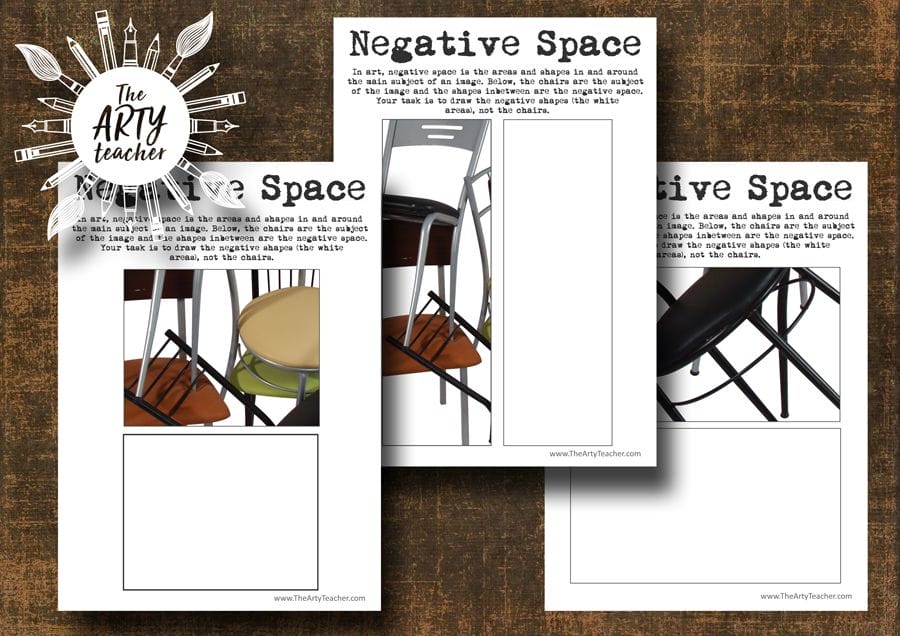
Subscribe & save in any currency! I WANT TO PAY IN Australian Dollars ($) Canadian Dollars ($) Euros (€) Pound Sterling (£) New Zealand Dollar ($) US Dollars ($) South African rand Change Currency
Free subscription, for one teacher, premium subscription, premium plus subscription, for one or more teachers.

Sarah Crowther – The Arty Teacher
I set up The Arty Teacher because I have a passion for my subject that I want to share with other art teachers around the world.
I have been a high school art teacher for over 20 years, so I understand what it’s like to be in front of a class of students, often with very different abilities and attitudes.
I wanted to develop resources that would help teachers to bring out the best in every student in every class. I also wanted to free-up staff from time-consuming lesson preparation to let them focus instead on delivering exciting, motivating, dynamic lessons, supported by excellent resources.
Privacy Overview
| Cookie | Duration | Description |
|---|---|---|
| cookielawinfo-checbox-analytics | 11 months | This cookie is set by GDPR Cookie Consent plugin. The cookie is used to store the user consent for the cookies in the category "Analytics". |
| cookielawinfo-checbox-functional | 11 months | The cookie is set by GDPR cookie consent to record the user consent for the cookies in the category "Functional". |
| cookielawinfo-checbox-others | 11 months | This cookie is set by GDPR Cookie Consent plugin. The cookie is used to store the user consent for the cookies in the category "Other. |
| cookielawinfo-checkbox-necessary | 11 months | This cookie is set by GDPR Cookie Consent plugin. The cookies is used to store the user consent for the cookies in the category "Necessary". |
| cookielawinfo-checkbox-performance | 11 months | This cookie is set by GDPR Cookie Consent plugin. The cookie is used to store the user consent for the cookies in the category "Performance". |
| viewed_cookie_policy | 11 months | The cookie is set by the GDPR Cookie Consent plugin and is used to store whether or not user has consented to the use of cookies. It does not store any personal data. |
Username or Email
Lost Password?

Artist Research
Ai generator.
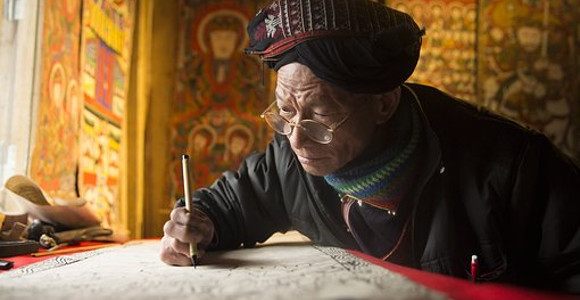
Work of Art and Artwork
Some people use words they already understand may have a different meaning when used through a different perspective. In common usage, the terms’ artwork’ and ‘work of art’ are interchangeable. But in the world of art studies, they mean different things. ‘Artwork’ is the production and its outcome. This term refers to the performance, painting, drawing, poems, etc. ‘Work of art,’ on the other hand, is said to be the work that art does. Whatever movement in concepts, methodologies, material practice, sensorial and work experience , and other epiphanies that arise while making art is ‘work of art’ of art. Artistic research analyzes these two to report new knowledge.
10+ Artist Research Examples
There is no one correct meaning to art. There are untold truths hidden within the product and process of making art. It would have to take a non-traditional way of thinking to assess and analyze an artist’s performance and work. This is where artistic research comes in. To give you more insight on how artistic research is conducted, here are 10+ artistic research examples you can check out.
1. Artist Project Report Example
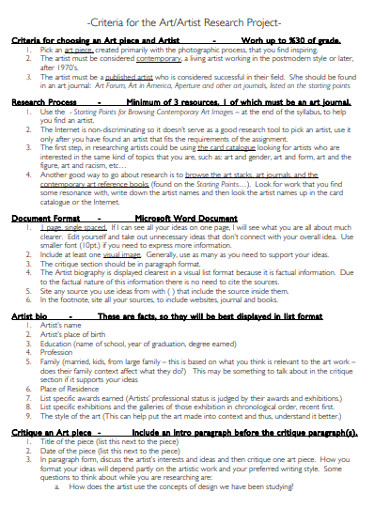
Size: 52 KB
2. Artist Research Questions Worksheet Example
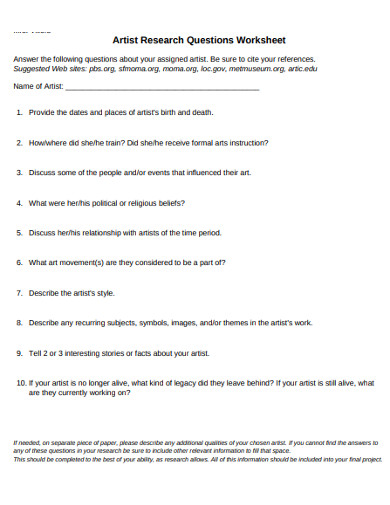
Size: 43 KB
3. Famous Artist Research Example
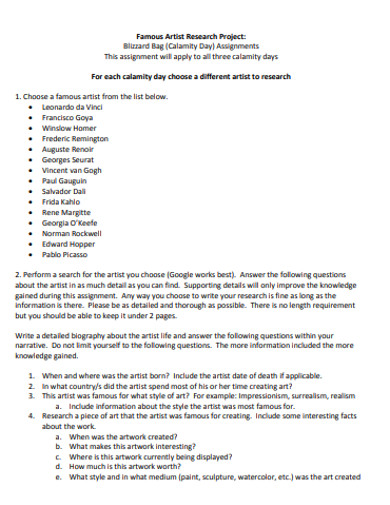
Size: 185 KB
4. Artist Research and Development Grant Budget Form

Size: 32 KB
5. Interdisciplinary Artist Research Program Example
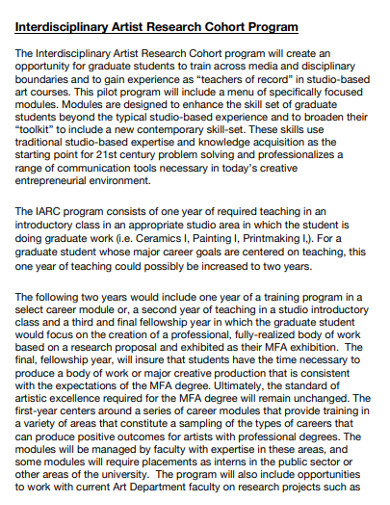
Size: 40 KB

6. Simple Artist Research Example
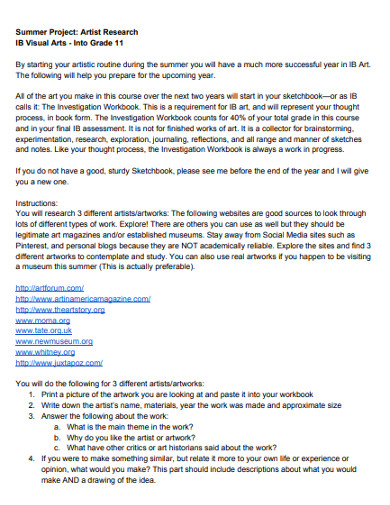
Size: 65 KB
7. Teaching Artist Research Example
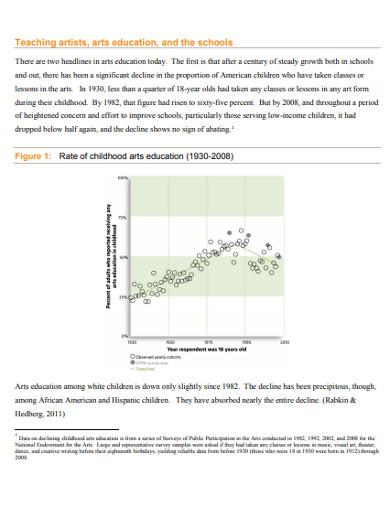
Size: 991 KB
8. Artist Research and Residency Program Example
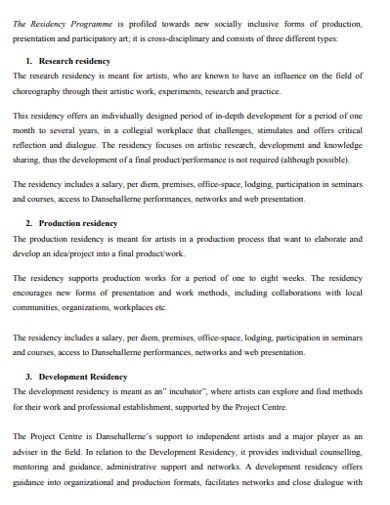
Size: 694 KB
9. Independent Artist Research Example
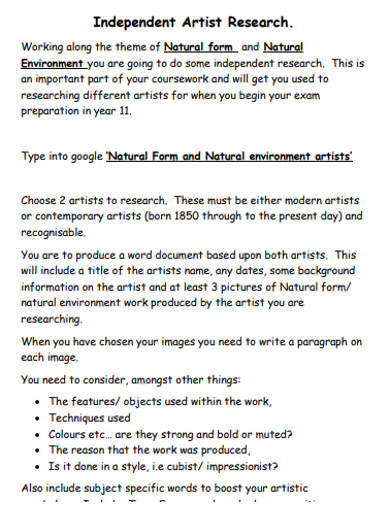
Size: 47 KB
10. Artist Leader Research Example
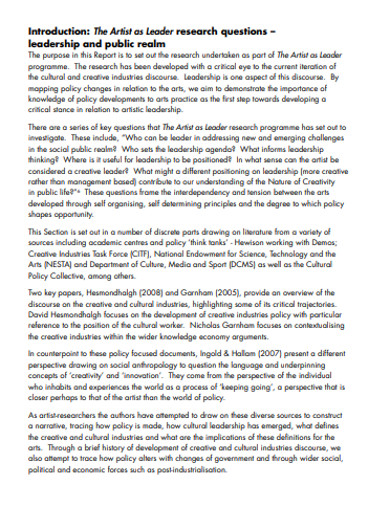
Size: 186 KB
11. Internet Artist Research Worksheet Example
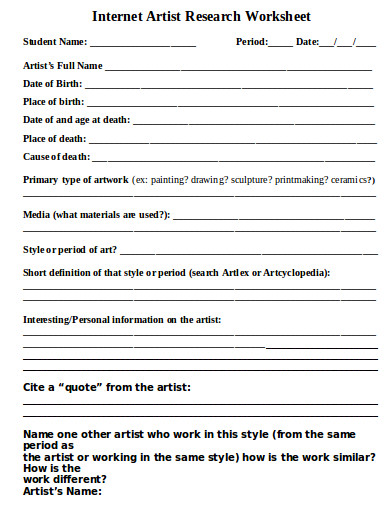
Method to the Madness
Artistic research requires a firm understanding of art and its theories. You also need to have had an artistic experience that you can analyze in your study. This means that it requires a solid strategy to help accurately conduct it. As with any research, there are several different research methods researchers can utilize to accomplish their artistic research project. Below is a list of a few techniques you can choose from.
Action Research
After finishing the artwork, the artist or researcher looks to see if there is anything that needs improving. Action research focuses on analyzing the actions of the artist to help him grow and refine his work. Although there is no correct way of making art, researchers always assumed that it could be better. By using the action research method for your research project , you can formulate an effective improvement plan for your work.
Content Analysis
As discussed, art holds many various insights. Looking into every little detail of the artwork is called content analysis. Since art is used for infographics and marketing flyers , studying its content could help in understanding the whole document. Color schemes, figures, and movements could represent something more profound; that’s why researchers use content analysis to figure them out.
Critical Discourse Analysis
In the literary arts, what is said can mean something different. You need to be able to analyze the art history , figures of speech and positioning of the text. This type of data analysis is done with critical discourse analysis. This method studies social relations, knowledge, and identity, and how they are constructed in written text. Literary artistic research relies on this method more often than not.
Media Analysis
For those making formal essays in the art of film, plays, and television, media analysis might be the one you need. This analysis is a subset of content analysis that focuses mainly on mass media. This analyzes film transcripts and whatnot. Media analysis gathers and examines quantitative and qualitative data. This type of analysis studies and evaluates data from various kinds of media.
Usability Studies
Art often represents a particular scene, era, phenomenon, or demographic. Some also use visual and performing arts as tools to depict the behaviors of specified groups of people. This technique is why usability studies are one of the many methods of artistic research. This method looks at art as tools and reviews their uses for reasons lie lesson and study plan .
Behind every painted picture, every spoken poem, every song, and every dance lies the secrets of the universe. Not everyone can see it, but some are lucky enough to get a glimpse.
Text prompt
- Instructive
- Professional
10 Examples of Public speaking
20 Examples of Gas lighting
New NPM integration: design with fully interactive components from top libraries!
5 Art Portfolio Examples that Will Leave you Awestruck

An art portfolio is a curated collection of an artist’s best work. It promotes the artist’s work and attracts potential employers, clients, galleries, or educational institutions. Most professional artists present their portfolio in form of an artist website and today we’re going to go through a couple of artist portfolios to help you build one.
Website builders feel stifling? Create a custom web design with UXPin, a prototyping tool that doesn’t limit your imagination. Add UI elements that you need, test your prototype with users, and easily build cross-platform, user-friendly digital products you feel proud of. To design even faster, use our Tailwind UI library and copy and paste fully coded web design sections that can be customized. Try UXPin Merge for free .
Create beautiful layouts without designers
Design production-ready prototypes 8.6x faster. No pixels. pure code.

What is an art portfolio?
An art portfolio is a collection of an artist’s work that showcases their skills and style. It serves as a professional curation, often used for presenting their work to potential clients, applying for jobs or academic programs, and presenting at exhibitions or galleries.
An art portfolio can be physical or digital, but in the modern context, online art portfolios are more prevalent. Most artists have their own websites that they use to post their work, stay in touch with the art world or even run an online store where people can buy their work.
5 Art Portfolio Website Examples
Julia plath.
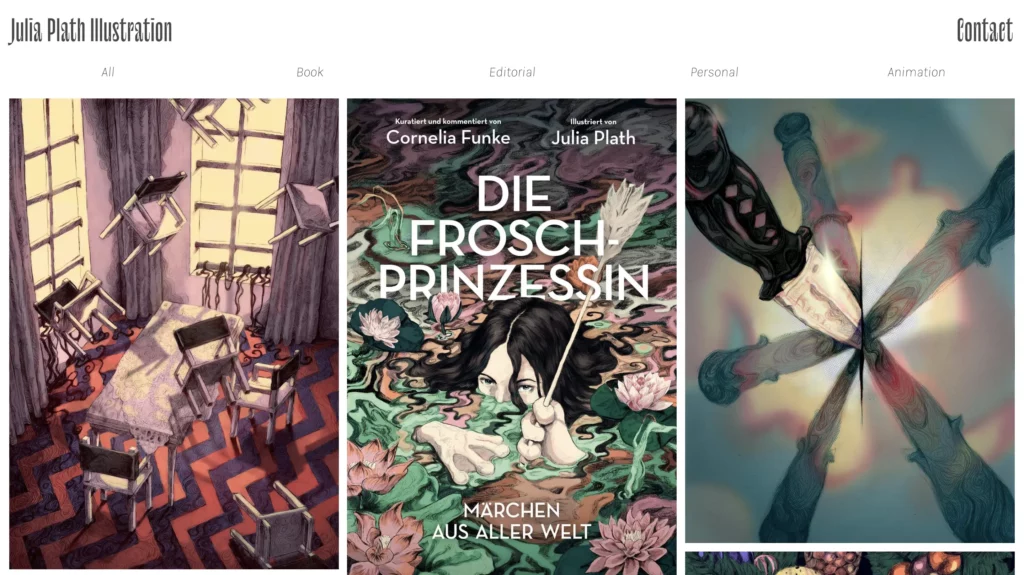
Julia Plath’s online art portfolio website effectively showcases her work with a minimalist design that emphasizes the artwork. The site excels in visual presentation and simplicity , making it easy for users to focus on the illustrations , admire the artist’s technical skills, and find contact information.
The website is visually appealing, using a minimalist and clean design. It focuses on the artwork with a white background that highlights the images without distraction. When it comes to typography , simple, sans-serif fonts are used, consistent with the minimalist approach. The text is legible and complements the visual elements without overshadowing the artwork.
A predominantly black-and-white color scheme ensures the artwork stands out. Colors used are minimal and primarily come from the art pieces themselves, drawing attention to them.
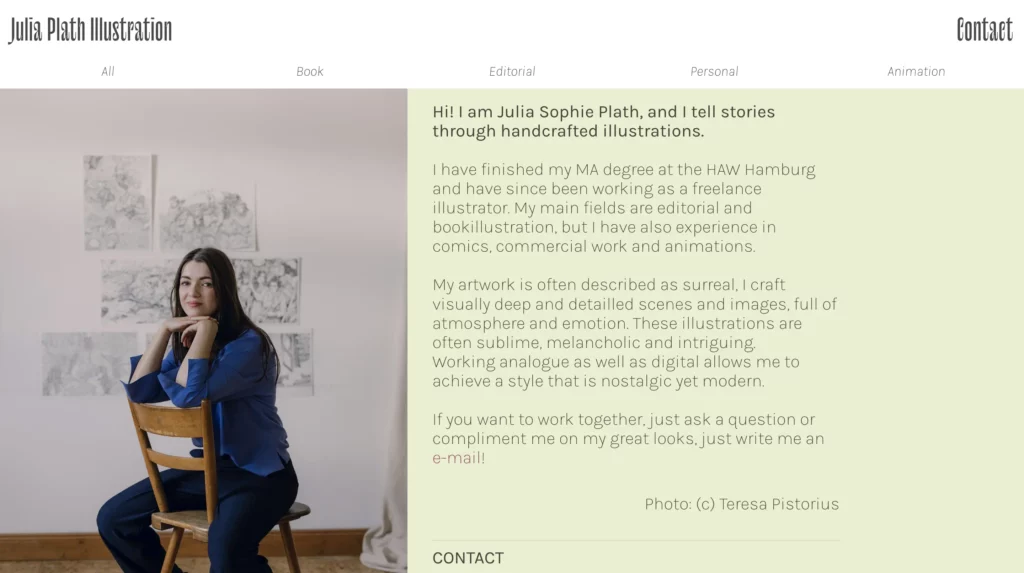
The website has intuitive navigation. The menu is clear and accessible at the top of the page, leading to sections like Home, Portfolio, About, and Contact.
While the design is visually appealing, the site could improve on accessibility aspects. For instance, adding more descriptive alt text for images and ensuring text contrast is high enough for readability.
The website has limited interactivity , focusing mainly on viewing the artwork. There is a subtle hover effect on images, enhancing the user interaction without overwhelming the design.
Bonnie White
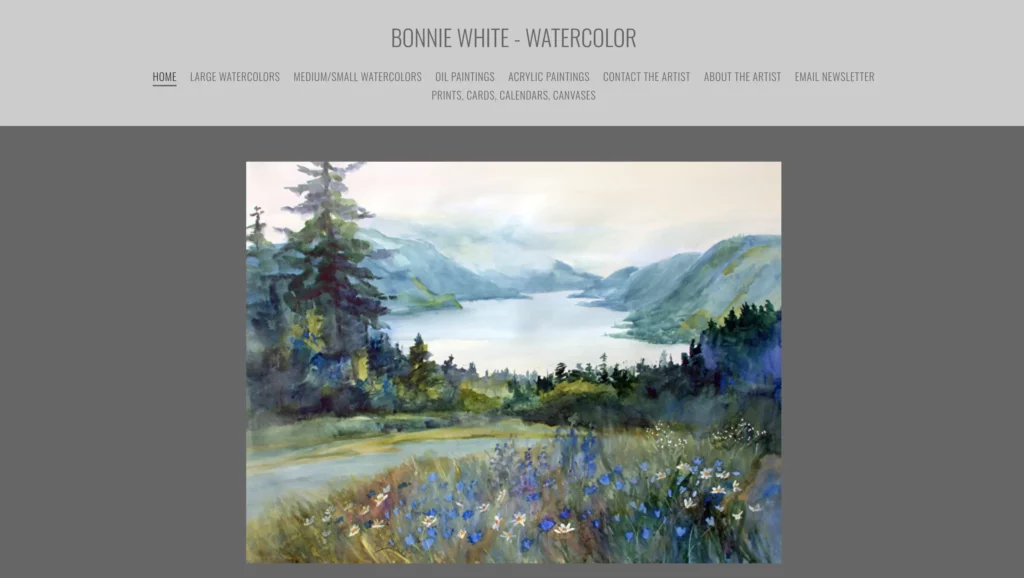
Bonnie White’s portfolio site showcases a distinct approache to digital portfolio design and brings to mind traditional fine art websites. It’s well-made in terms of SEO , featuring a blog that adds dynamic content to the site, engaging visitors with updates and insights into the visual artist’s process and activities.
Her design portfolio embraces a warm, vibrant aesthetic with a soft color palette that complements her folk art, creating an inviting and personal atmosphere. Artwork is well-organized and displayed with ample spacing. Each piece is accompanied by titles and descriptions, offering context to viewers. The portfolio is accessible directly from the main menu, making it easy to browse .
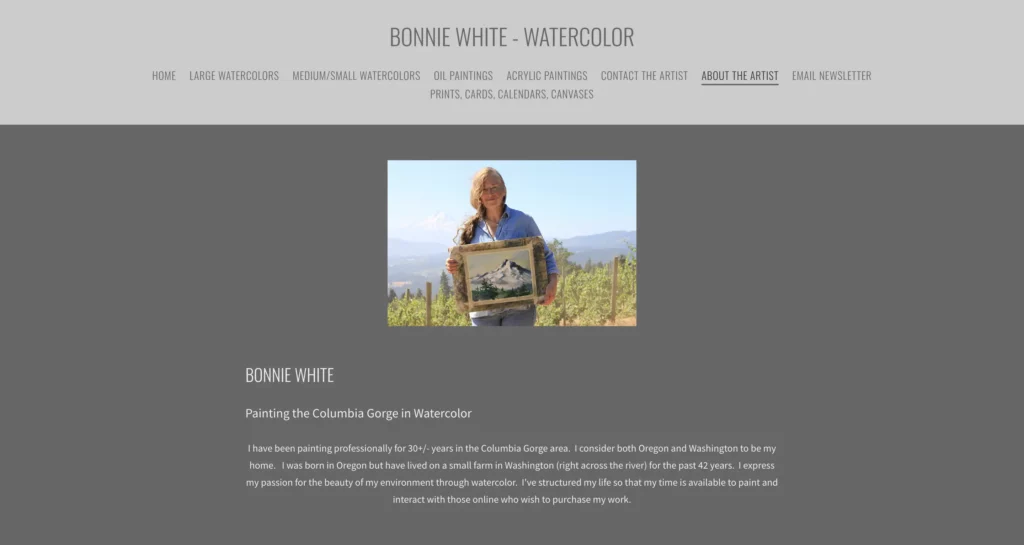
Fonts are clean and readable, with a mix of serif and sans-serif. The titles use a decorative serif font that adds a personal touch, while body text is in a simple sans-serif, balancing readability with style.
The use of earthy and pastel colors aligns well with the folk art theme. The colors are not overwhelming and help create a cohesive look that reflects the artist’s personality.
The site is fairly accessible with reasonable text contrast and alt text for images. However, some improvements could be made, such as ensuring all text is large enough for readability and enhancing keyboard navigation.
Camille Walala
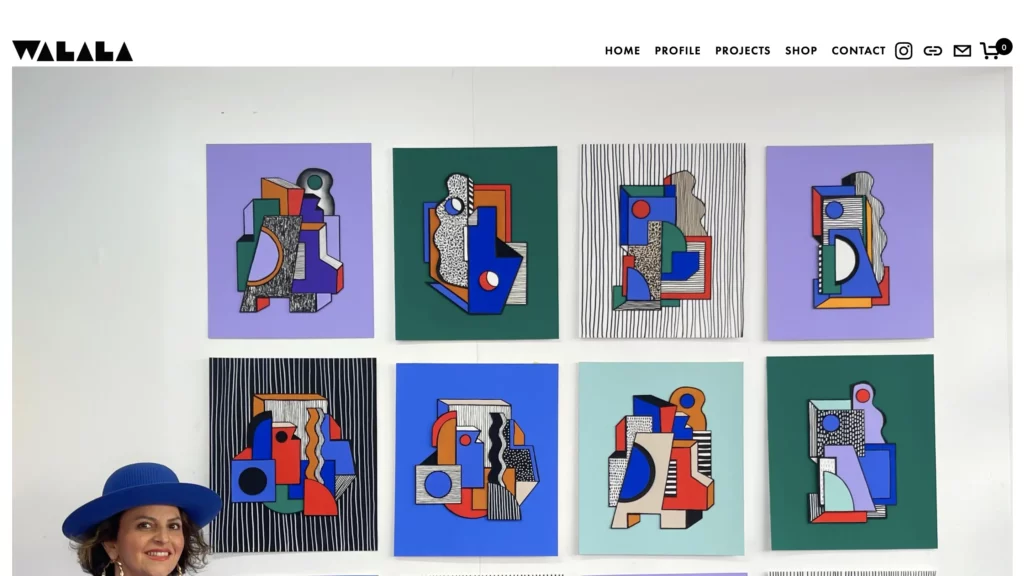
The art portfolio of Camille Walala has a dynamic and vibrant design that mirrors the artist distinctive graphic design-like style. It uses bold colors and geometric shapes throughout, effectively capturing the essence of her work.
The homepage features full-screen images of her most striking projects, giving a dramatic presentation that immerses the visitor in her world of art. This approach effectively showcases the scale and impact of her installations.
The top navigation menu is straightforward, with clear labels like Work, About, and Contact. This simplicity ensures that users can quickly find what they’re looking for without distraction.
The website design incorporates a vivid color palette, primarily consisting of bright blues, reds, yellows, and blacks. These colors are consistent with Walala’s artistic style and create a cohesive visual experience.
The typography is playful yet clean, featuring bold fonts for headings and simple, sans-serif fonts for body text. This balance maintains readability while adding to the site’s energetic feel.
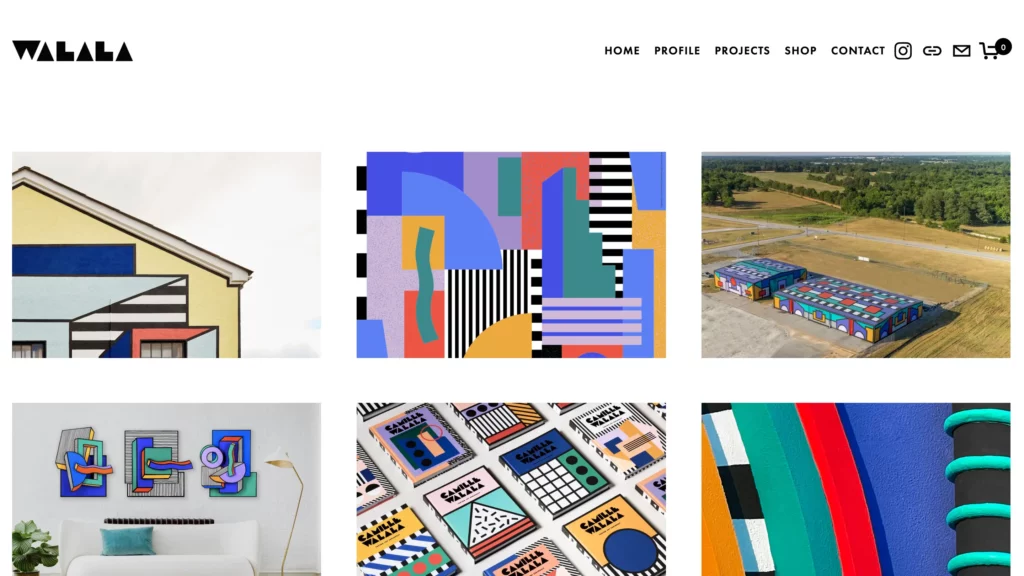
High-quality images of Walala’s work are prominently displayed. The website effectively uses full-screen images and slideshows to showcase her projects in various settings, making her portfolio visually impactful.
While the site is well-optimized for performance and user experience , there are areas for potential improvement, particularly in accessibility and SEO, which could further enhance its effectiveness and reach.
Timothy Goodman
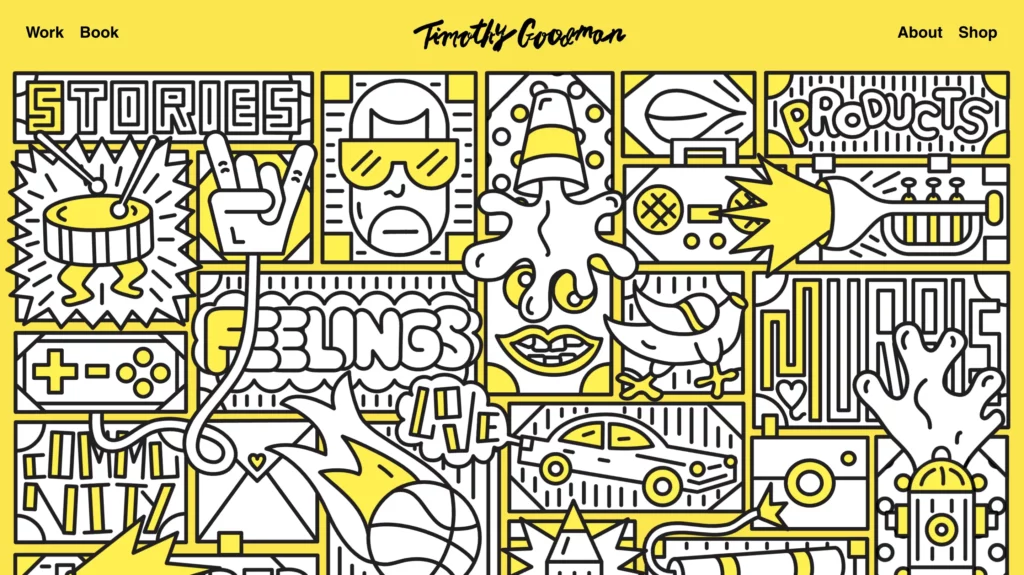
Timothy Goodman is another visual artists whose online art portfolio is a great example of good web design and a great presentation of visual arts. Based in New York City, Goodman is known for his distinctive graphic style and has created numerous public art installations, illustrations, and typographic works throughout New York and beyond.
Timothy Goodman’s own portfolio successfully captures the essence of his artistic style through its bold , vibrant, and playful design. The intuitive navigation, responsive layout , and engaging visual elements create a positive user experience. The site effectively showcases his diverse body of work while providing clear paths for exploration and interaction.
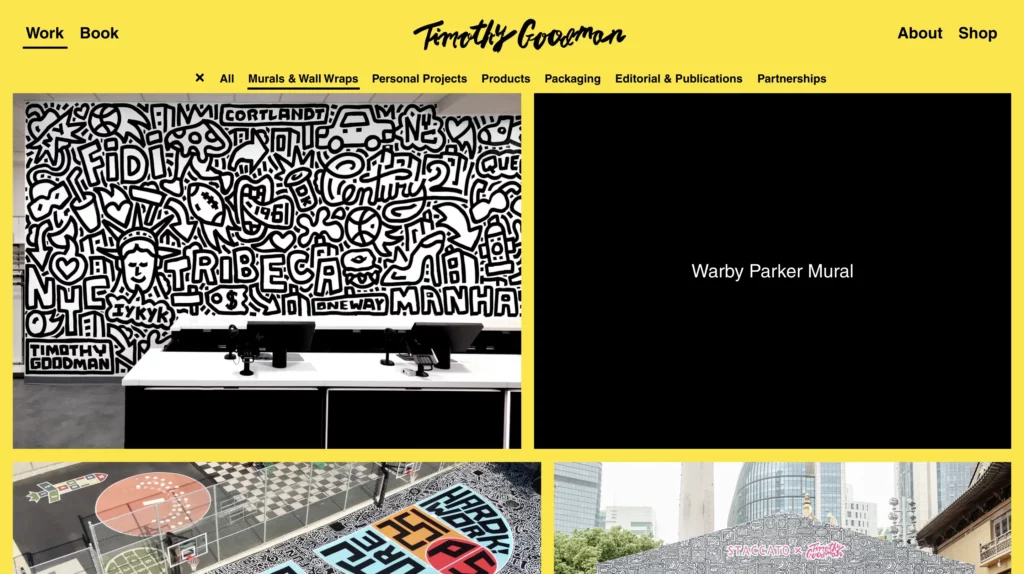
Hovering over project thumbnails in the Work section triggers visual feedback, such as color changes, zoom effects, or brief overlays with project titles. This interaction invites users to explore and signals that the images are clickable.
Navigation buttons and links change color or style upon hovering, providing a clear indication of their interactivity.
Each project thumbnail is clickable , leading to a dedicated page with detailed images, descriptions, and context for the project. This interaction makes it easy for users to delve deeper into specific works that interest them. Clicking on project links dynamically loads the new content without refreshing the entire page, ensuring a seamless user experience.
Lily Clementine Orset
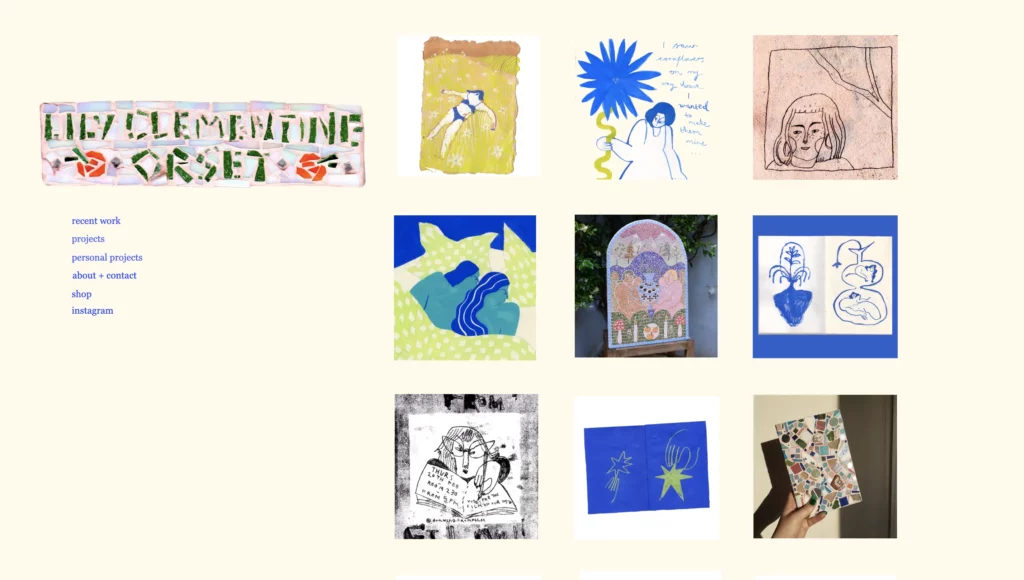
Lily Clementine Orset uses a unique and unconventional approach to present her art. The web design of this online art portfolio reflects an experimental and DIY aesthetic, aligning with her artistic vision and providing a different experience compared to traditional portfolio websites.
The interface allows users to click and drag elements, enhancing the interactive and hands-on feel of the site.
The use of textured backgrounds and layered images gives the site a tactile, handmade quality that complements the DIY ethos of her work.
The website employs a mix of hand-drawn and digital fonts, contributing to its quirky and artistic vibe. The variety in font styles adds to the visual interest but might affect readability in some areas. Font sizes vary across the site, which adds to the eclectic feel but can create challenges in maintaining a clear visual hierarchy and readability.
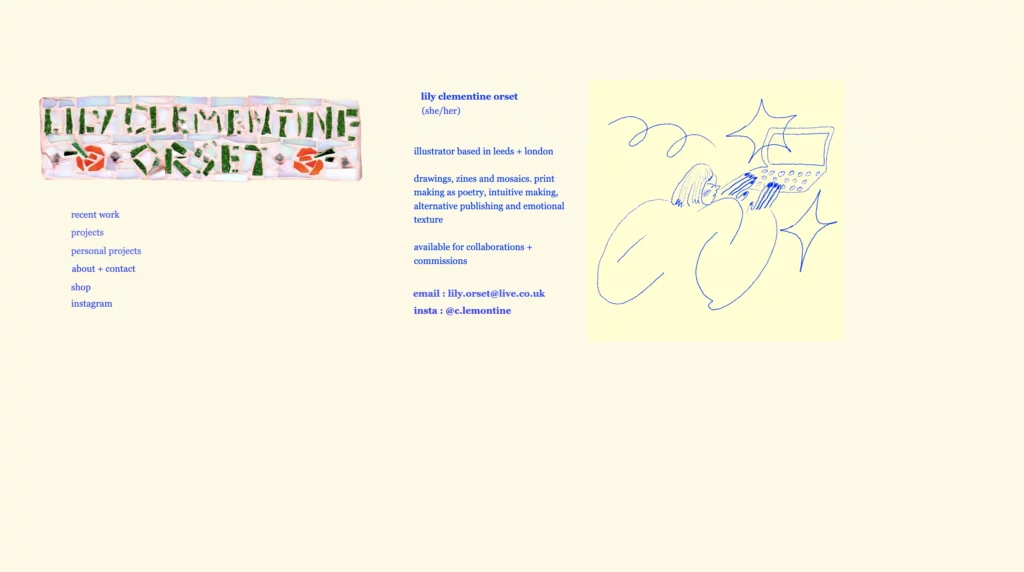
The site is designed primarily for desktop use, with the interactive elements best experienced on larger screens. On mobile devices , the navigation and interactions may be less effective or more cumbersome. Elements might not scale well on different screen sizes, potentially affecting the browsing experience on tablets and smaller screens . Having said that, the interactive design invites exploration and encourages users to spend more time on the site, though it may also create some usability challenges.
10 UX and UI tips based on those art portfolios
Effective UX and UI design is crucial for art portfolio websites to showcase the artist’s work, engage visitors, and create a memorable browsing experience. Here are some tips to follow when creating your art portfolio website:
- Align with Art Style: Ensure the website’s design reflects the artist’s style. Use colors, fonts, and layouts that complement the artwork.
- Showcase Artwork Effectively: Use high-resolution images that capture the details and colors of the artwork. Include full-screen images, close-ups, and various views to give a comprehensive presentation.
- Use Neutral Backgrounds: Opt for neutral backgrounds to make artwork stand out. A simple color scheme (e.g., white, black, or gray) ensures the focus remains on the art.
- Apply Readable Fonts: Use clean and readable fonts. Ensure font sizes and colors provide good readability against the background.
- Clear Menu Structure: Provide a simple and intuitive navigation menu with clear labels such as Home, Gallery, About, Blog, and Contact. Make sure the menu is accessible from all pages.
- Breadcrumbs: Use breadcrumbs or a similar mechanism to help users understand their location within the site and easily navigate back to previous pages.
- Responsive Design: Ensure the website is fully responsive. Design layouts that adjust smoothly across different devices and screen sizes, including desktops, tablets, and smartphones.
- Interactive Elements: Incorporate subtle hover effects and clickable images to enhance interactivity. Ensure that interactions are intuitive and provide visual feedback, such as highlighting clickable elements or changing colors on hover.
- Categorize Work: Organize artwork into categories or series. This helps visitors find specific types of work quickly and provides a structured browsing experience.
- Optimize Performance: Optimize images and code to reduce loading times. Fast performance is crucial for keeping visitors engaged and reducing bounce rates.
Design your own website today
We’ve seen five totally different art portfolios today and what would you say about creating your own with UXPin? Drag and drop interactive UI elements that have code behind them, arrange the perfect layout of your website and then, copy the code to build your own site. Try UXPin Merge for free .
Use a single source of truth for design and development. Discover Merge

by UXPin on 13th June, 2024
UXPin is a web-based design collaboration tool. We’re pleased to share our knowledge here.
UXPin is a product design platform used by the best designers on the planet. Let your team easily design, collaborate, and present from low-fidelity wireframes to fully-interactive prototypes.
No credit card required.
These e-Books might interest you

Design Systems & DesignOps in the Enterprise
Spot opportunities and challenges for increasing the impact of design systems and DesignOps in enterprises.

DesignOps Pillar: How We Work Together
Get tips on hiring, onboarding, and structuring a design team with insights from DesignOps leaders.
We use cookies to improve performance and enhance your experience. By using our website you agree to our use of cookies in accordance with our cookie policy.
- International
- Education Jobs
- Schools directory
- Resources Education Jobs Schools directory News Search

Artist Research Template Worksheet
Subject: Art and design
Age range: 16+
Resource type: Worksheet/Activity
Last updated
18 February 2021
- Share through email
- Share through twitter
- Share through linkedin
- Share through facebook
- Share through pinterest

This printable PDF will help your students to gather relevant artist research as well as advising them of how to organise it within their sketchbook.
The prompts encourage students to ask the right questions about the influences and media used in the artwork, as well as thinking about how they can apply their findings to their own work.
I hope you find it to be useful.
Creative Commons "Sharealike"
Your rating is required to reflect your happiness.
It's good to leave some feedback.
Something went wrong, please try again later.
Very useful, thanks.
Empty reply does not make any sense for the end user
miguelcabeza
Thank you for sharing!
artinpractice
No problem! Thank you for your kind review :-)
Report this resource to let us know if it violates our terms and conditions. Our customer service team will review your report and will be in touch.
Not quite what you were looking for? Search by keyword to find the right resource:

IMAGES
VIDEO
COMMENTS
Learn how to create effective artist research pages with these good examples from art teachers. See how to include images, annotation, personal response and artist analysis in your pages.
Hi everyone! In this video I take you through the structure I use to write about artists work to ensure you cover everything in your image analysis! I hope y...
A guide for GCSE and A Level Art and Design students on what to include and how to layout Artist Research for Assessment Objective 1. Using the work of Tim J...
GCSE Artist Research Guide. Creating research about artists is a creative and exciting part of a GCSE course. It will allow you to discover new artworks and learn about how artists think and work. This GCSE artist research guide will help you find an appropriate artist, analyse their work and present your research to a GCSE standard.
A worksheet to guide KS4 students on how to do artist research and present it in an appropriate way. It provides a template, prompts and 20 questions to encourage relevant and thoughtful responses to other artists' work.
How to make an artist page. This lesson is aimed at key stage three students and focuses on the artist Amy Sherald.Music: lightMusician: Jef
A worksheet for GCSE art and design students to learn how to layout and annotate an artist research page. It includes a guide, a list of questions and a file preview.
February 8, 2017. One simple step to improve artist research in your students sketchbooks: give them the material - text information, images and questions - they need to come up with meaningful insights and high quality responses. Easier said than done, possibly…. I have long been perplexed at the lack of writing and publishing on the ...
This one-page resources is a simple list of do's and don'ts. For example, don't refer to an artist by their first name only, don't use pictures the size of stamps, do create an even spread of images and text. There are 16 do's and don'ts and as this is an editable Word document you can edit and update this to suit your own needs.
Art Source This link opens in a new window Art Source covers a broad range of related subjects, from fine, decorative and commercial art, to various areas of architecture and architectural design. Full text plus abstracts and indexing of an array of peer-selected publications, indexing going back as far as 1929 for some publications.
Learn how to research and respond to artists for your GCSE Graphics project. See examples of mood boards, research pages and visual responses with grading criteria and tips.
How to Analyse Artists' work Artists' research and analysis is worth 25% of marks at GCSE, A/S & A Level. ow to Analyse Artists' work:Artists' research and analysis is wort. 2. % of marks at GCSE, A/S & A LevelWhen writing about artis. . work you should co. ment on the following.1. What media is the artwork and what is the subject matter??
Artist Research Step By Step. Subject: Art and design. Age range: 11-14. Resource type: Visual aid/Display. File previews. pdf, 3.23 MB. Step by step guide of how to create an artist research page. The helpsheet includes examples of good artists research pages. Sentence starters not included: if you leave a review I will send over to you for ...
Here at Beyond we have summarised everything you need to know about researching an artist. Learn how to write an introduction to the artist, analyse their work and to evaluate your own work. Download FREE teacher-made resources covering 'Artist Research Guide'. View FREE Resources.
We all look for different things when assessing an art research page. That is why this download includes two different, editable versions of an assessment rubric. A basic version and a comprehensive version. The basic version includes a 'what to include' column, presentation of pictures, good quality research and creating a balance on the page.
Artist Research Page: A page dedicated to an Artist (Artist can be Visual, Literary, Craftsman, etc.) This page should include: The Birth & Death Dates of the Artist. Examples of the Artist's work. Describe, Analyze, Interpret. Background Information on the Artist. Judge: Why you chose and admire this artist or why you don't like this Artist.
A PDF poster with tips and examples for producing excellent artist research pages. Suitable for KS3, KS4 and KS5 art and design students, in A3 and A4 formats.
IT'S THE BEST WAY TO LEARN. You can write a lot about a single artwork when you know what you are looking for. Practice reading through the questions below when looking at a picture, like the one above by Agnes Cecile, and see how many you can answer: Remember. Recall what you already know about Art. Remind yourself of key terms and concepts.
Age range: 14-16. Resource type: Lesson (complete) File previews. pptx, 3.55 MB. pptx, 733.48 KB. pptx, 138.82 KB. pptx, 873.12 KB. Use the powerpoints and worksheets provided to help guide GCSE students with their initial artist research - how to do it, how to design and layout the page and how to develop their ideas through artist research.
To give you more insight on how artistic research is conducted, here are 10+ artistic research examples you can check out. 1. Artist Project Report Example. d.umn.edu. Details. File Format. PDF. Size: 52 KB. Download.
5 Art Portfolio Website Examples Julia Plath. Julia Plath's online art portfolio website effectively showcases her work with a minimalist design that emphasizes the artwork. The site excels in visual presentation and simplicity, making it easy for users to focus on the illustrations, admire the artist's technical skills, and find contact information.
A great resource for improving the quality of artist research pages! Use as a draft to gather information and then transfer into sketchbooks or mounted pages in a creative way. This two-page PDF gives students guidance and inspiration to produce excellent artist research pages. Primary targets are KS4, but can be used equally with KS3 and KS5.
Artist research pages. Subject: Art and design. Age range: 14-16. Resource type: Lesson (complete) File previews. pptx, 7.02 MB. This is an ideal resource that shows how to create an engaging, creative and well written artist research page and an analysis of work. This is suitable for any project, but would ideally suit the independent project ...
Artist Research Template Worksheet. Subject: Art and design. Age range: 16+. Resource type: Worksheet/Activity. File previews. pdf, 185.02 KB. This printable PDF will help your students to gather relevant artist research as well as advising them of how to organise it within their sketchbook. The prompts encourage students to ask the right ...